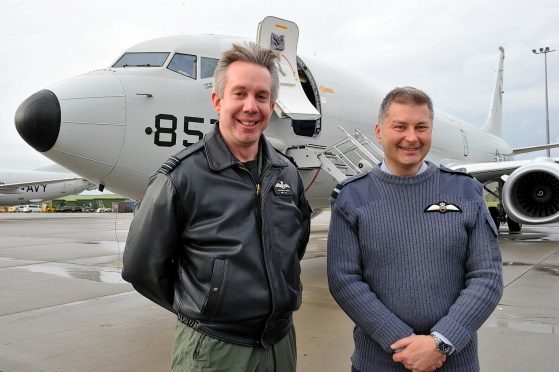Flying aces who honed their skills at the former RAF Kinloss base are poised to return to the region when a fleet of new spy plans arrive.
The UK Government has purchased nine P-8 Poseidon aircraft, each worth about £150million, which will be based at RAF Lossiemouth.
Military officials held a briefing at the station yesterday, where they outlined the massive defence boost which the Boeing maritime patrol aircraft will provide.
And Air Commodore Ian Gale confirmed that flight crew who had developed extensive surveillance knowledge working with Nimrod planes at RAF Kinloss are winging their way back to Moray to ensure a successful transition.
The former RAF Lossiemouth station commander is overseeing the project to install the craft at the airfield.
Air Cdre Gale said: “Expertise developed in Moray is now being brought back here.
“I have managed to get a number of people with that Nimrod background employed over the time I have been working on this programme.
“Now we are in the delivery phase, and people who have houses or are from Moray are looking forward to bringing their skills – and their families – back to the area.
“In addition to that, a lot of former Nimrod personnel from RAF Kinloss are now working in our National Maritime Information Centre in London.
“That is the centre for operations of this nature, and will support the Poseidon activities at Lossiemouth.”
Former RAF Kinloss Nimrod expert, Squadron Leader Andy Bull, is the programme manager for the fleet that is expected to commence operations in Moray by 2020.
Sqn Ldr Bull spent three years working with the US Navy after the Nimrod programme was abandoned in 2011.
He added: “It was decided that the UK would want to have surveillance aircraft again in the future and it was in our interest to maintain those skills.
“Despite technological advances, it is the quality of the people working on this that could make the difference between success and failure. It’s reassuring to know we do have the right people.”
Air Cdre Gale was Group Captain at RAF Lossiemouth from November 2011 to November 2013.
Yesterday, he met Moray’s council and economic leaders at the Lossiemouth station’s maritime air operations centre to update them on how the base was preparing for the Poseidon planes’ arrival.
They were offered an insight into the detailed weather analysis that Poseidon pilots receive prior to taking off.
And US Navy Captain, James Robinson, displayed the advanced computer control unit which serves the Poseidon planes while they are on an operation.
The machinery weighs 65,000lbs, is worth £7.6million, and Capt Robinson described it as the “heartbeat” of air surveillance operations.
The invited dignitaries then completed a sensational first – as the only UK civilians ever to take to the air in a Poseidon aircraft.
The American plane which they boarded is part of a fleet currently based at RAF Lossiemouth for the mammoth Joint Warrior war games exercise.
The UK Government finalised the purchase of the machines in July, and revealed plans to create a £100million training centre alongside them.
It will be used as the main training base for Boeing’s defence aircraft across Europe, and is expected to launch in 2019.
More than 400 new personnel will be stationed at Lossiemouth to operate the aircraft, and another 100 people will be recruited for the support centre.
The estimated cost of developing the planes could reach £3billion over the next decade.
The move has been welcomed as a means of plugging defence gaps caused by the Ministry of Defence scrapping Nimrod surveillance aircraft, which led to the demise of RAF Kinloss.
